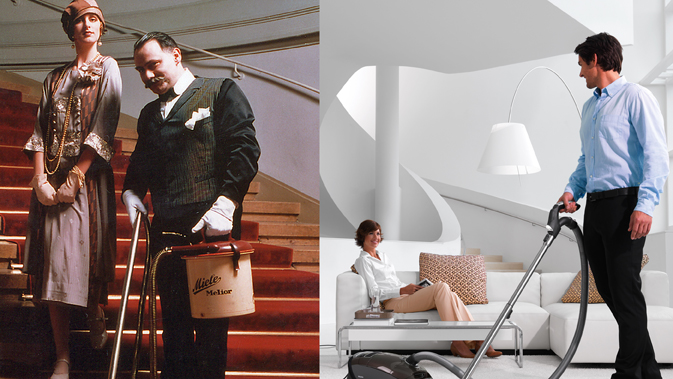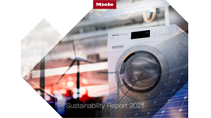Press releases
From bucket-type cleaner to robovac

Vacuum cleaning with Miele: 90 years of Bielefeld expertise
With almost a century of floor care experience, Miele is a pioneer in many disciplines in this field. Or, to be more precise, Miele's Bielefeld production plant. Exceptional quality, the ultimate in user convenience, superb cleaning performance and a timelessly beautiful design - this has been Miele's claim since 1927. Today, the Westphalian family-owned company produces more than 2 million vacuum cleaners per year. In Western Europe, for example, no other brand sells more canister vacs. The fan and cable reel are manufactured by the Miele factory in Euskirchen, while the casing and other plastic parts are supplied by the Miele factory in Warendorf.
The first machines to hit the market were metal bucket-type units, later followed by an elongated form reminiscent of a torpedo on skids. Forms and materials have changed over the years. Increasingly, plastics have become the material of choice on vacuum cleaners. This makes models lighter, more nimble and – mindful of the risk of electric shocks – safer, too. During the same period, the undercarriage has seen everything from wheels to skids and today's free-wheeling swivel castors.
Over the course of the years, fans have become more powerful but at the same time smaller and more compact. And as insulation methods improved, it has been possible to slash sound emissions quite drastically. Current Miele machines feature an energy-efficient motor which achieves excellent cleaning results – and have raked in many firsts with consumer test institutes. When it comes to quality and durability, Miele has always placed the highest of demands on its products: Before Miele vacuum cleaners are shipped to customers, they are put through their paces in gruelling laboratory tests which simulate 20 years of use. To pass these tests, the motor must run for 1000 hours uninterruptedly at the highest power setting without the least hiccup. Further endurance tests include probing the robustness of the casing, the tensile strength and the flexibility of the hoses and the proper functioning of cable reels and switches.
The current canister vacuum cleaner range meets all wishes and needs regarding performance, features, convenience and energy efficiency: The Cat & Dog model for households with pets, Medicair for allergy sufferers or 'Parquet & Co.' for homes with delicate hard floors are just a few examples. Models from the EcoLine range are highly energy-efficient despite their sterling performance: These machines with a rating of 1300 W or 1200 W have been test winners with Germany's consumer watchdog Stiftung Warentest (StiWa) for many years. Only recently, Miele claimed first place with its S 8340 EcoLine (test 2/2014). And, in anticipation of the energy labelling system to be introduced in September 2014 which will cap power output at 1600 W, Miele naturally already has its ducks in a row: More than three-quarters of the models in the current product portfolio already meet tomorrow's requirements today.
The S 8 Silence Plus, first presented at IFA 2013, has a specially insulated 700 W motor which even achieves the top A energy-efficiency rating. The high level of cleaning performance which customers have come to expect from the S8 is achieved through a high motor efficiency factor in combination with the AirTeQ floorhead which is specifically designed for use on low-wattage models. With the new HEPA AirClean filter, which achieves filtration of 99.95%, this soft-spoken representative of its kind is also the ideal proposition for allergy sufferers.
With the Scout RX1 robovac, Miele is treading new ground and once again setting standards with its combination of unique Smart Navigation, Triple Cleaning and the excellent charge and battery life of its rechargeable lithium-ion batteries. A full battery guarantees sufficient power for 2 hours of vacuum cleaning, during which an area of up to 150 m² can be cleaned. And, even after 300 recharging cycles, the battery still has the same oomph as it had when new.
(656 words, 4.252 characters incl. spaces)
Company profile: Miele is the world leader in the field of premium domestic appliances including cooking, baking and steam-cooking appliances, refrigeration products, coffee makers, dishwashers and laundry and floorcare products. This line-up is augmented by dishwashers, washer-extractors and tumble dryers for commercial use as well as washer-disinfectors and sterilisers for use in medical and laboratory applications (Miele Professional). The company, founded in 1899, has 8 production plants in Germany and one plant each in Austria, the Czech Republic, China and Romania. 2012/13 turnover amounted to approx. EUR 3.15 bn with sales outside Germany accounting for 70%. Miele is represented with its own sales subsidiaries and via importers in almost 100 countries. The Miele company, now in the fourth generation of family ownership, employs a workforce of around 17,250 with two-thirds in Germany. The company headquarters are located in Gütersloh/Westphalia, Germany.
Milestones: Vacuum cleaners 'Made in Bielefeld'
1927
First Miele bucket-type vacuum cleaner launched.
1931
Model 'L', a vacuum cleaner in torpedo shape, is particularly suited to use in small homes and flats. New features on this model are a rubber bumper strip to protect furniture, and a gentle carpet attachment.
1952
Miele expands its vacuum cleaner range by adding its first stick vac, the Mielette.
1954
For increased manoeuvrability, the 'President' is installed on skids. It also features a two-stage footswitch and a case for storage.
1960
The rectangular-looking 'Präsident S' replaces the torpedo form and has, by the standards of the day, a very high-powered 600 W motor.
1969
Introduction of the S series with the S 200, the first Miele vacuum cleaner casing to be made entirely from plastic. New features include the height-adjustable telescopic suction hose and the use of two filters (motor and air discharge filters).
1981
Vacuum cleaners now feature on-board accessories, easily accessible under the accessory compartment lid. Miele also demonstrates its competence in the field of electronics with the introduction of electronic suction control.
1985
Convenient and energy-saving: the Automatic setting adapts suction to the type of flooring.
1986
Miele is first to market with vacuum cleaners with a lacquered surface finish.
1993
The layer of active charcoal on the new Active AirClean filters absorbs unpleasant smells, for instance from pet's hairs. Particulate filters (later called Active HEPA filters) ensure maximum air hygiene. As even the tiniest particles are held back, room air is cleaner after vacuuming than before.
1999
New accessories: The MicroSet for cleaning computer keyboards and delicate collectibles as well as the CarClean set for car interiors.
2001
Improved filtration and cleaning performance is offered by Miele's new multi-ply IntensiveClean dust bags made from random-spun fibres.
2002
Miele vacuum cleaners from the S 700 and S 800 series fitted with an Active HEPA filter are awarded the 'Suitable for Allergy Sufferers' label by the RWTÜV Systems material testers for room air hygiene excellence.
2004
Launch of the Allergotec floorhead: This counts dust particles and shows how clean a floor covering is using a traffic-light indicator (red, amber, green).
2005
Introduction of the new S5 flagship series. Like its S4 predecessor, the S5 is also awarded an air hygiene certificate by RWTÜV. The 30-millionth Miele vacuum cleaner leaves the factory gates at Miele Bielefeld.
2007
With the S5 Ecoline, a vacuum cleaner with an output of only 1300 W is test winner with Stiftung Warentest for the first time.
2009
At the IFA trade show in Berlin, Miele presents the world's first hybrid vacuum cleaner which, thanks to an additional rechargeable battery, can continue cleaning for a further 20 minutes when out of the reach of a wall socket.
2012
April: Successful and mature – Miele's S5, which has by now recorded sales of almost 7 million units, rakes in its fourth test win with Stiftung Warentest. May: Launch of the new S8 flagship model range, the proud owner of the coveted RedDot award, presented even before the official market launch.
2013
Miele presents the S8 Silence Plus, featuring a highly efficient 700 W motor already capable of achieving the top- A energy efficiency rating in the energy labelling scheme due to come into effect in September.
2014
January: The S8's premiere with Stiftung Warentest is acknowledged with top marks in the ratings. The model tested is the S 8340 EcoLine with 1200 W. 'Vacuums best' is the verdict of test experts. May: Miele's first robovac, the Scout RX1, is launched via retailers.
Media information
| Description | Download |
|---|---|
 90 years of floor care experience in Bielefeld: The first machines to hit the market were metal bucket-type units (left), the current canister vacuum cleaner range like the S8 (right) meets all wishes and needs regarding performance, features, convenience and energy efficiency.
90 years of floor care experience in Bielefeld: The first machines to hit the market were metal bucket-type units (left), the current canister vacuum cleaner range like the S8 (right) meets all wishes and needs regarding performance, features, convenience and energy efficiency.
|
|
| High Resolution JPG |


